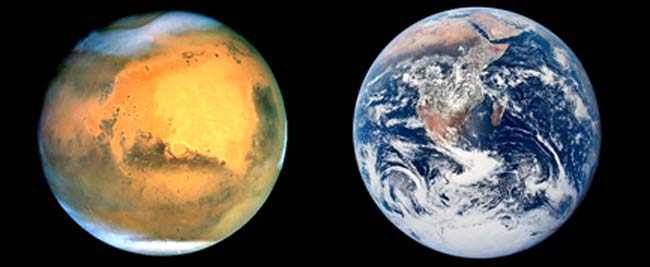Earth vs. Mars: Polar Opposites

The ends of the Earth and the ends of Mars are both extreme locations. While the poles of both planets are unique, they share some remarkable similarities.
"The poles on Mars are a lot like Antarctica," said James Head, a planetary geologist at Brown University. "It's a very arid, very cold desert. The Antarctic Dry Valleys, for example, are the most Mars-like environment on Earth."
The Martian poles resemble Antarctica, at Earth's South Pole, because both are covered with a relatively thin layer of ice on top of rock, while our own North Pole is a liquid ocean with shifting layers of ice floating on top of it.
The ice caps on Mars are roughly as thick as the ice cap on Antarctica — both are about a mile-and-a-half (two to three kilometers) deep.
While the ice on Earth is made of water, Mars' ice is a combination of water-ice and frozen carbon dioxide, or "dry ice."
And if you thought Earth's poles were frigid, avoid the tips of Mars, where surface temperatures are around 150 Kelvin, or −189.67 degrees Fahrenheit (-123.15 degrees Celsius). Our own South Pole generally gets down to around −85 degrees Fahrenheit (−65 degrees Celsius) and our North Pole is much warmer, with lows of around −45 degrees Fahrenheit (−43 degrees Celsius).
Polar bears, seals and arctic foxes frolic near Earth's North Pole, and birds and fish are sometimes sighted there. And Antarctica is home to those adorable Emperor Penguins, as well as Snow Petrel birds, blue whales and orcas. Meanwhile, no life has been found yet on Mars' poles (or anywhere else on the red planet), though scientists are holding out hope for microbes, perhaps in liquid water buried deep under the surface.
Get the world’s most fascinating discoveries delivered straight to your inbox.
While humans have yet to set foot on Mars, people live year-round at McMurdo station on Antarctica. For the first explorers to Earth's poles, though, the journey was a challenge akin to our current goal of sending astronauts to the red planet. The first sighting of Antarctica was in the 1820s, and humans didn't actually touch down on the southern continent until the 1890s.
In 1909, American explorer Robert Peary claimed to be the first person to reach the North Pole, though many scholars question whether he actually achieved this feat.
About a half century later, humans sent the first unmanned missions to Mars.
In July 1965, NASA's Mariner 4 spacecraft made the first flyby of the planet, snapping the first up-close photos. Ten years later, in July 1976, NASA's Viking 1 spacecraft landed on Mars. And this Sunday, NASA's Phoenix spacecraft is scheduled to set down in the northern polar region of Mars. Scientists hope the upcoming mission will shed more light on the differences between our planet and our neighbor, and maybe even find evidence for the greatest similarity of all: life.
- 101 Amazing Earth Facts
- The Top 10 Martian Landings of All Time
- Gallery: Ice of the Antarctic



